Effects of Partial Straw Mulching on Potato Production under Different Rainfall Years in Dry-Farming Region
Abstract
1. Introduction
2. Materials and Methods
2.1. Experimental Site
2.2. Experimental Scheme
2.3. Measurements and Calculations
2.3.1. Soil Temperature
2.3.2. Soil Water Content
2.3.3. Soil Water Storage and Water Consumption Calculation
2.3.4. Yield Measurement
2.3.5. Water Use Efficiency (WUE) Calculation
2.4. Data Analysis
3. Results
3.1. Soil Temperature
3.2. Soil Water Storage
3.3. Soil Water Consumption
3.4. Potato Tuber Yield and Water Use Efficiency (WUE)
3.5. Correlations Analysis of Various Indices
4. Discussion
4.1. The Effect of Partial Straw Mulching on Soil Temperature
4.2. The Effect of Partial Straw Mulching on Soil Moisture
4.3. The Efect of Partial Straw Mulching on Potato Tuber Yield and WUE
5. Conclusions
- (1)
- The ridge planting and furrow mulching straw pattern significantly reduced soil temperatures in all growth periods of potatoes and had a significant effect on water storage and moisture retention.
- (2)
- The potato tuber yield and WUE were significantly increased by the ridge planting and furrow mulching straw pattern. In normal rainfall years, the ridge planting and furrow mulching straw pattern reduced the water consumption before the BP and the total water consumption during the whole growing period was not significantly different from that of CK; in moderately dry years, the total water consumption during the whole growth period was significantly lower than that of CK.
- (3)
- Additionally, from the results of correlation analyses, the formation of tuber yield was highly and positively correlated with the average soil temperature during the TB and SA, as well as the water consumption from the BP to TB and the soil water storage during the TB and the MA.
Author Contributions
Funding
Data Availability Statement
Acknowledgments
Conflicts of Interest
References
- FAO (Food and Agricultural Organization). Online Statistical Databases. 2016. Available online: http://faostat3.fao.org/ (accessed on 19 October 2023).
- Luo, Q.Y.; Gao, W.J.; Lv, J.F.; Gao, M.J. Analysis of the development situation of China’s potato industry in 2021–2022. Potato Industry and Seed Industry Innovation (2022). In Proceedings of the China Potato Congress, Qiqihaer, China, 15–18 July 2022. [Google Scholar]
- Li, Q.; Li, H.B.; Zhang, L.; Zhang, S.Q.; Chen, Y.L. Mulching improves yield and water-use efficiency of potato cropping in China: A meta-analysis. Field Crops Res. 2018, 221, 50–60. [Google Scholar] [CrossRef]
- Qin, S.H.; Zhang, J.L.; Dai, H.L.; Wang, D.; Li, D.M. Effect of ridge-furrow and plastic-mulching planting patterns on yield formation and water movement of potato in a semiarid area. Agric. Water Manag. 2014, 131, 87–94. [Google Scholar] [CrossRef]
- Zhang, Q.; Zhang, C.J.; Bai, H.Z.; Li, L.; Sun, L.D.; Liu, D.X.; Wang, J.S.; Zhao, H.Y. New development of climate change in Northwest China and its impact on arid environment-overall warming and drying, local signs of warmth and humidity. J. Arid Meteorol. 2010, 28, 1–7. [Google Scholar] [CrossRef]
- Xiao, G.J.; Qiu, Z.J.; Zhang, F.J.; Ma, F.; Yao, Y.B.; Zhang, Q.; Wang, R.Y. Influence of increased temperature on the potato yield and quality in a semiarid district of Northwest China. Acta Ecol. Sin. 2015, 35, 830–836. [Google Scholar] [CrossRef][Green Version]
- Chen, Y.Z.; Tian, H.H.; Li, Y.W.; Chai, Y.W.; Li, R.; Cheng, H.B.; Chang, L.; Chai, S.X. Effects of straw strip mulching on furrows and planting in ridges on water use efficiency and tuber yield in dryland potato. Acta Agron. Sin. 2019, 45, 714–727. [Google Scholar] [CrossRef]
- Shi, M.F.; Kang, Y.C.; Zhang, W.N.; Yang, X.Y.; Fan, Y.L.; Yu, H.F.; Zhang, R.Y.; Guo, A.X.; Qin, S.H. Plastic film mulching with ridge planting alters soil chemical and biological properties to increase potato yields in semiarid Northwest China. Chem. Biol. Technol. Agric. 2022, 9, 16. [Google Scholar] [CrossRef]
- Qin, S.H.; Yeboah, S.; Cao, L.; Zhang, J.L.; Shi, S.L.; Liu, Y.H. Breaking continuous potato cropping with legumes improves soil microbial communities, enzyme activities and tuber yield. PLoS ONE 2017, 12, e0175934. [Google Scholar] [CrossRef] [PubMed]
- Qin, Y.Q.; Cheng, H.B.; Chai, Y.W.; Ma, J.T.; Li, R.; Li, Y.W.; Chang, L.; Chai, S.X. Increasing effects of wheat yield under mulching cultivation in Northern of China: A meta-analysis. Sci. Agric. Sin. 2022, 55, 1095–1109. [Google Scholar] [CrossRef]
- Xiao, L.G.; Zhao, R.Q.; Kuhn, N. Straw mulching is more important than no tillage in yield improvement on the Chinese Loess Plateau. Soil Tillage Res. 2019, 194, 104314. [Google Scholar] [CrossRef]
- Akhtar, K.; Wang, W.Y.; Khan, A.; Ren, G.G.; Afridi, M.Z.; Feng, Y.Z.; Yang, G.H. Wheat straw mulching offset soil moisture deficient for improving physiological and growth performance of summer sown soybean. Agric. Water Manag. 2019, 211, 16–25. [Google Scholar] [CrossRef]
- Niu, Y.N.; Zhang, R.Z.; Luo, Z.Z.; Li, L.L.; Cai, L.Q.; Li, G.; Xie, J.H. Contributions of long-term tillage systems on crop production and soil properties in the semi-arid Loess Plateau of China. J. Sci. Food Agric. 2016, 96, 2650–2659. [Google Scholar] [CrossRef] [PubMed]
- Wang, J.Y.; Mo, F.; Zhou, H.; Kavagi, L.; Nguluu, S.N.; Xiong, Y.C. Ridge—Furrow with grass straw mulching farming system to boost rainfed wheat productivity and water use efficiency in semiarid Kenya. J. Sci. Food Agric. 2020, 101, 3030–3040. [Google Scholar] [CrossRef] [PubMed]
- Chen, S.Y.; Niu, J.F.; Zhang, X.Y.; Shao, L.W.; Yao, Z.G.; Li, J.B. Temperature effects of straw mulching on the agronomic and physiological characteristics of winter wheat. Chin. J. Eco-Agric. 2022, 30, 820–830. [Google Scholar] [CrossRef]
- Yang, C.G.; Chai, S.X. Regulatory effects of bundled straw covering on winter wheat yield and soil thermal-moisture utilization in dryland. Chin. J. Appl. Ecol. 2018, 29, 3245–3255. [Google Scholar] [CrossRef]
- Li, F.; Zhang, G.H.; Chen, J.; Song, Y.L.; Geng, Z.G.; Li, K.F.; Siddique, K.H. Straw mulching for enhanced water use efficiency and economic returns from soybean fields in the Loess Plateau China. Sci. Rep. 2022, 12, 17111. [Google Scholar] [CrossRef] [PubMed]
- Chang, L.; Han, F.X.; Chai, S.X.; Cheng, H.B.; Yang, D.L.; Chen, Y.Z. Straw strip mulching affects soil moisture and temperature for potato yield in semiarid regions. Agron. J. 2020, 112, 1126–1139. [Google Scholar] [CrossRef]
- Lombardo, S.; Lo Monaco, A.; Pandino, G.; Parisi, B.; Mauromicale, G. The phenology, yield and tuber composition of ‘early’ crop potatoes: A comparison between organic and conventional cultivation systems. Renew. Agric. Food Syst. 2013, 28, 50–58. [Google Scholar] [CrossRef]
- Licciardello, F.; Lombardo, S.; Rizzo, V.; Pitino, I.; Pandino, G.; Strano, M.G.; Muratore, G.; Restuccia, C.; Mauromicale, G. Integrated agronomical and technological approach for the quality maintenance of ready-to-fry potato sticks during refrigerated storage. Postharvest Biol. Technol. 2018, 136, 23–30. [Google Scholar] [CrossRef]
- Douds, D.D., Jr.; Nagahashi, G.; Reider, C.; Hepperly, P.R. Inoculation with arbuscular mycorrhizal fungi increases the yield of potatoes in a high P soil. Biol. Agric. Hortic. 2007, 25, 67–78. [Google Scholar] [CrossRef]
- Krauss, A.; Marshner, H. Influence of nitrogen nutrition, day length and temperature on contents of gibberellic and abscisic acid and on tuberization in potato plants. Potato Res. 1982, 25, 13–21. [Google Scholar] [CrossRef]
- Woli, P.; Hoogenboom, G. Simulating weather effects on potato yield, nitrate leaching, and profit margin in the US Pacific Northwest. Agric. Water Manag. 2018, 201, 177–187. [Google Scholar] [CrossRef]
- Wang, F.; Cheng, H.B.; Li, H.; Chai, Y.W.; Chen, Y.Z.; Chang, L.; Huang, C.X.; Chai, S.X. Effect of bundled straw covering on soil temperature and yield of winter wheat in arid region. J. Triticeae Crops 2017, 37, 777–785. [Google Scholar] [CrossRef]
- Chen, S.Y.; Zhang, X.Y.; Sun, H.Y.; Shao, L.W. Cause and mechanism of winter wheat yield reduction under straw mulch in the North China Plain. Chin. J. Eco-Agric. 2013, 21, 519–525. [Google Scholar] [CrossRef]
- Gholamhoseini, M.; Dolatabadian, A.; Habibzadeh, F. Ridge-furrow planting system and wheat straw mulching effects on dryland sunflower yield, soil temperature, and moisture. Agron. J. 2019, 111, 3383–3392. [Google Scholar] [CrossRef]
- Yu, Y.Y.; Turner, N.; Gong, Y.H.; Li, F.M.; Fang, C.; Ge, L.J.; Ye, J.S. Benefits and limitations to straw and plastic film mulch on maize yield and water use efficiency: A meta-analysis across hydrothermal gradients. Eur. J. Agron. 2018, 99, 138–147. [Google Scholar] [CrossRef]
- Zhang, D.; Hu, W.L.; Liu, H.B.; Du, L.F.; Xu, Y.; Cheng, Z.H.; Sun, S.Y.; Wang, H.Y. Characteristics of residual mulching film and residual coefficient of typical crops in North China. Trans. Chin. Soc. Agric. Eng. 2016, 32, 2639–2646. [Google Scholar] [CrossRef]
- Li, R.; Cui, R.M.; Jia, Z.K.; Han, Q.F.; Lu, W.T.; Hou, X.Q. Effects of different furrow-ridge mulching ways on soil moisture and water use efficiency of winter wheat. Sci. Agric. Sin. 2011, 44, 3312–3322. [Google Scholar] [CrossRef]
- Wang, J.; Sainju, U.M. Aggregate-associated carbon and nitrogen affected by residue placement, crop species, and nitrogen fertilization. Soil Sci. 2014, 179, 153–165. [Google Scholar] [CrossRef]
- Zhang, M.; Cheng, G.; Feng, H.; Sun, B.H.; Zhao, Y.; Chen, H.X.; Chen, J.; Dyck, M.; Wang, X.D.; Zhang, J.G.; et al. Effects of straw and biochar amendments on aggregate stability, soil organic carbon, and enzyme activities in the Loess Plateau, China. Environ. Sci. Pollut. Res. 2017, 24, 10108–10120. [Google Scholar] [CrossRef]
- Zribi, W.; Aragüés, R.; Medina, E.; Faci, J.M. Efficiency of inorganic and organic mulching materials for soil evaporation control. Soil Tillage Res. 2015, 148, 40–45. [Google Scholar] [CrossRef]
- Yan, Q.Y.; Yang, F.; Dong, F.; Lu, J.X.; Li, F.; Duan, Z.Q.; Zhang, J.C.; Lou, G. Yield loss compensation effect and water use efficiency of winter wheat under double-blank row mulching and limited irrigation in northern China. Field Crops Res. 2018, 216, 63–74. [Google Scholar] [CrossRef]
- Ma, J.T.; Chen, H.B.; Chen, Y.Z.; Li, Y.W.; Lan, X.M.; Li, R.; Chai, Y.W.; Chang, L.; Chai, S.X. Effects of different mulching practices on soil water consumption and potato tuber yield in dryland farming. Chin. J. Ecol. 2020, 39, 2242–2250. [Google Scholar] [CrossRef]
- Abedinpour, M.; Sarangi, A.; Rajput, T.B.S.; Singh, M.; Pathak, H.; Ahmad, T. Performance evaluation of AquaCrop model for maize crop in a semi-arid environment. Agric. Water Manag. 2012, 110, 55–66. [Google Scholar] [CrossRef]
- Wu, C.H.; Pu, X.K.; Zhou, Y.J.; Mian, Y.P.; Miao, F.F.; Li, R. Effects of ridge-and-furrow rainwater harvesting with mulching on soil water-heat-fertility and potato yield in arid areas of southern Ningxia. Acta Agron. Sin. 2021, 47, 2208–2219. [Google Scholar] [CrossRef]
- Yang, J.X.; Zhang, H.Y.; Lin, Y.P.; Wu, L.K.; Wu, G.P. Discussion on the relationship between soil temperature fluctuation and potato tuber development. Shaanxi J. Agric. Sci. 2007, 53, 131–133. [Google Scholar] [CrossRef]
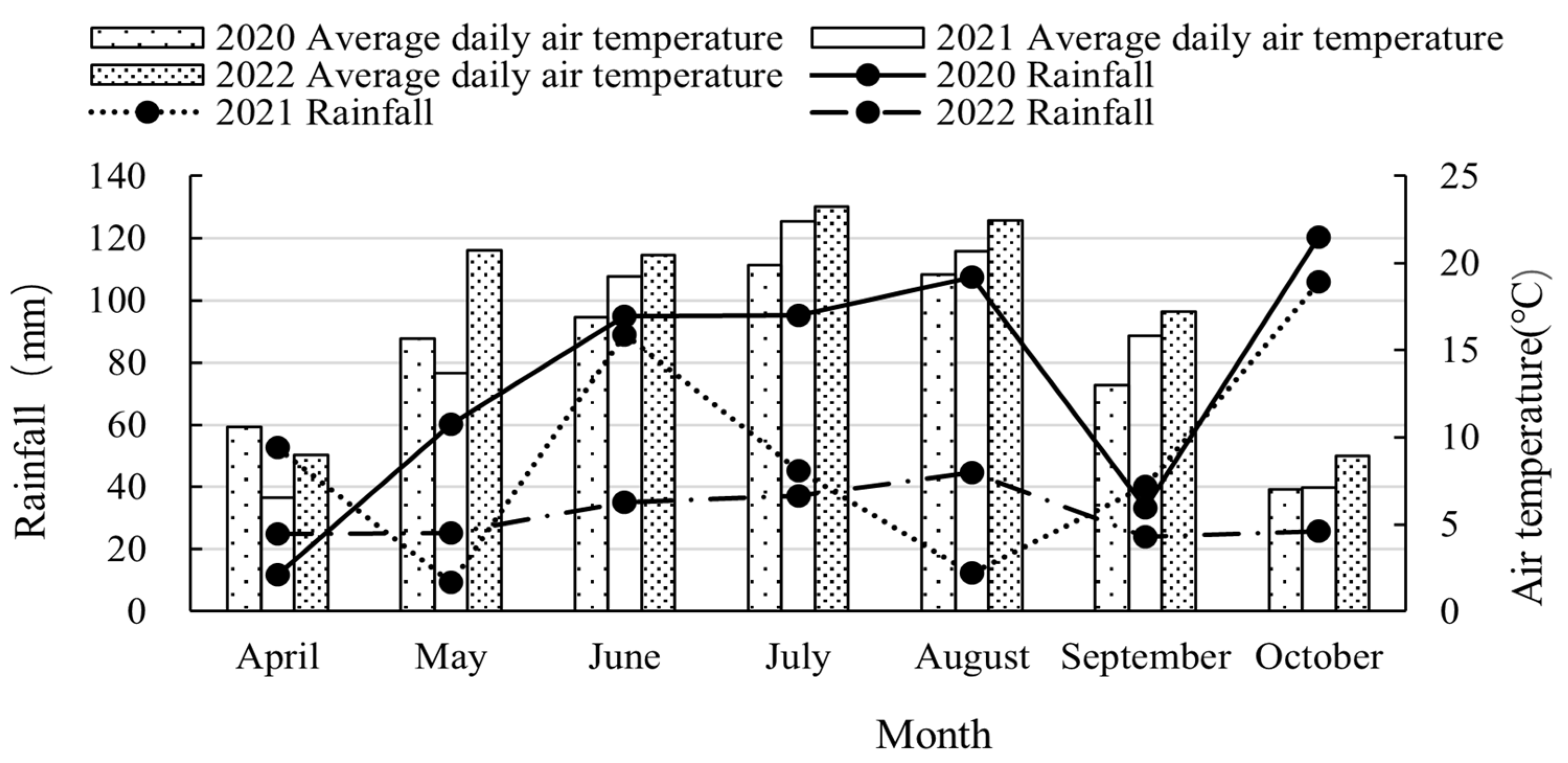
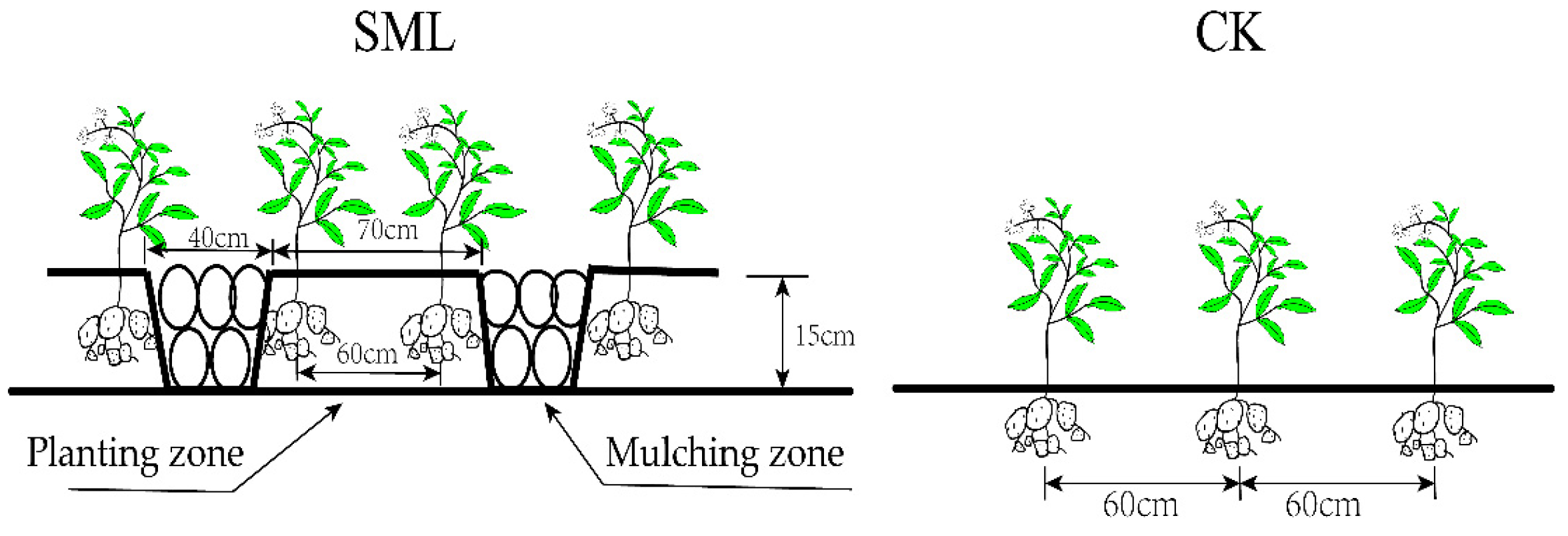
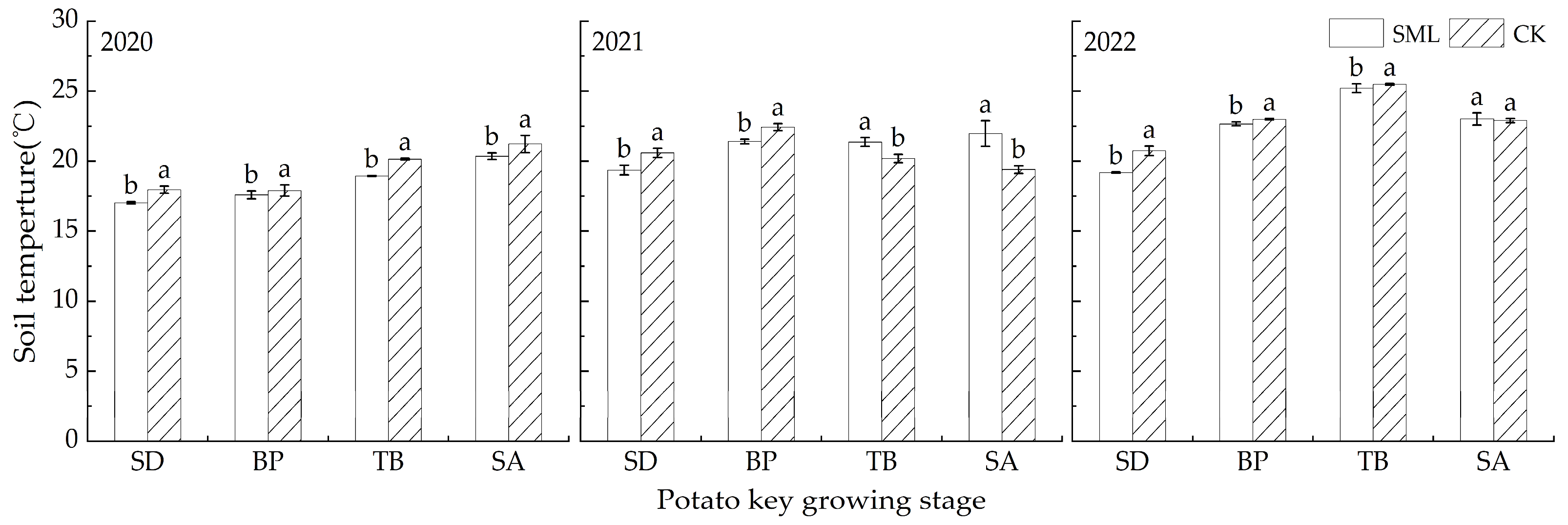

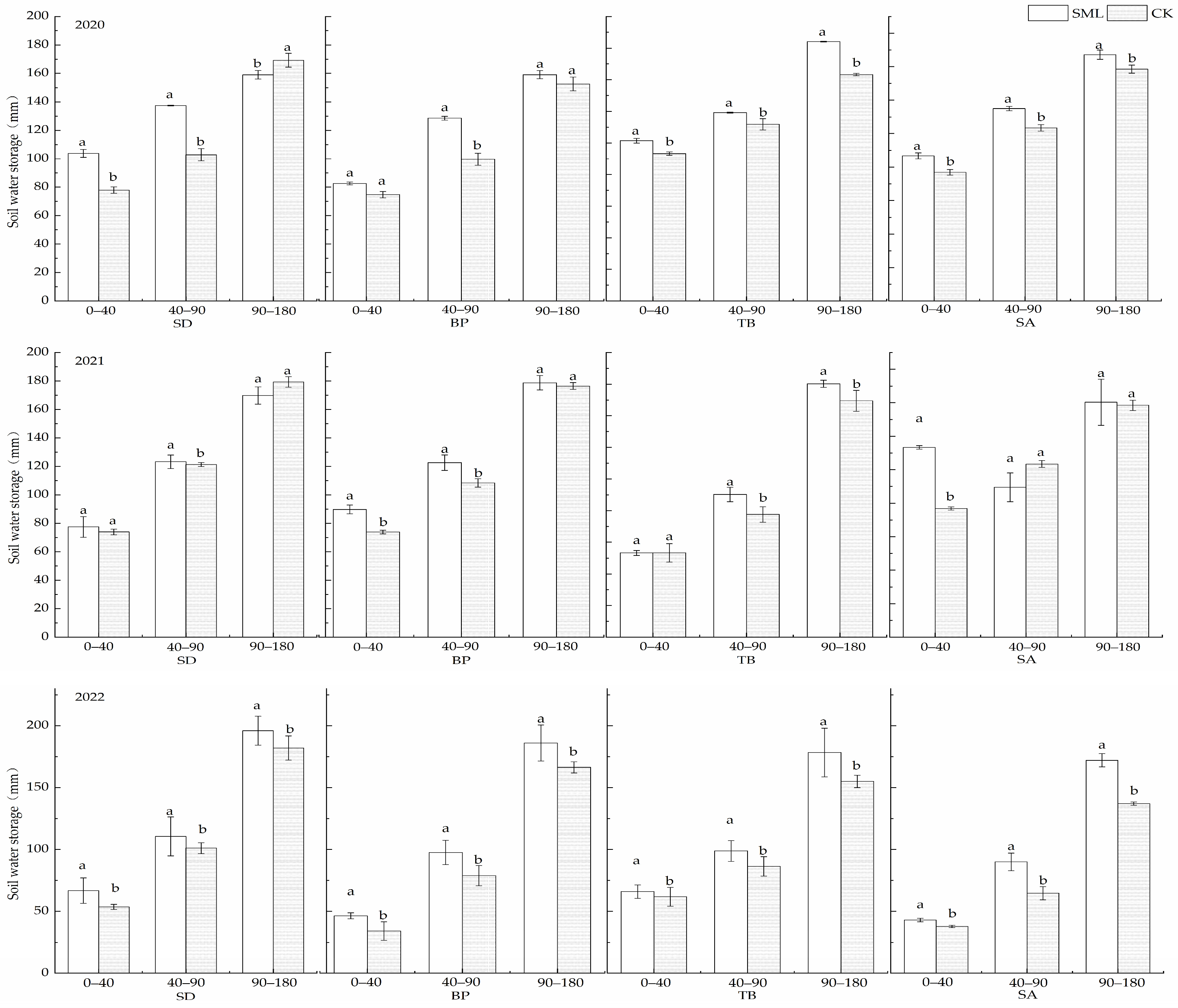


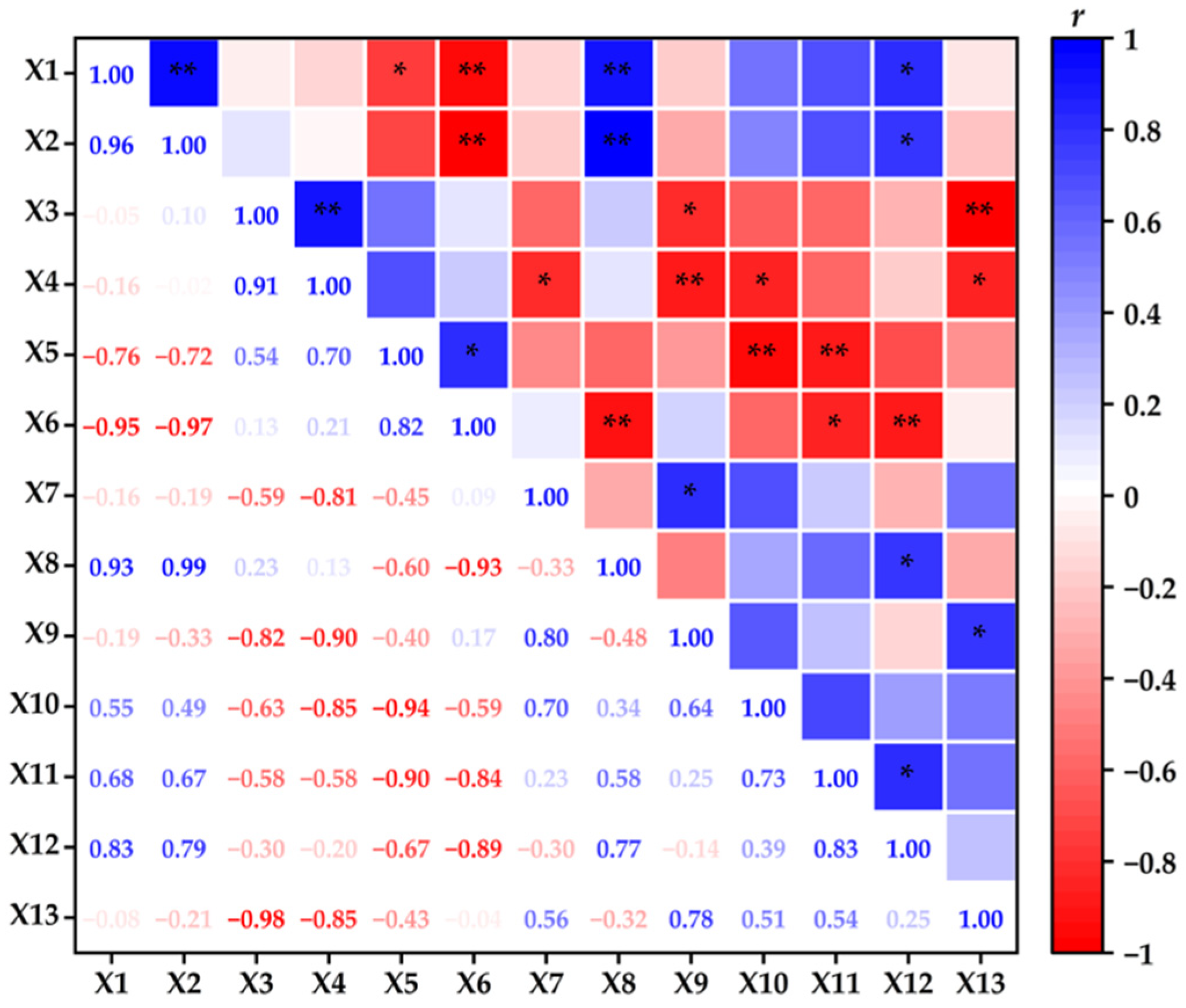
Disclaimer/Publisher’s Note: The statements, opinions and data contained in all publications are solely those of the individual author(s) and contributor(s) and not of MDPI and/or the editor(s). MDPI and/or the editor(s) disclaim responsibility for any injury to people or property resulting from any ideas, methods, instructions or products referred to in the content. |
© 2023 by the authors. Licensee MDPI, Basel, Switzerland. This article is an open access article distributed under the terms and conditions of the Creative Commons Attribution (CC BY) license (https://creativecommons.org/licenses/by/4.0/).
Share and Cite
Zhao, D.; Ma, J.; Cui, X.; Hu, L.; Wang, Z.; Chang, L.; Huang, C. Effects of Partial Straw Mulching on Potato Production under Different Rainfall Years in Dry-Farming Region. Water 2023, 15, 3971. https://doi.org/10.3390/w15223971
Zhao D, Ma J, Cui X, Hu L, Wang Z, Chang L, Huang C. Effects of Partial Straw Mulching on Potato Production under Different Rainfall Years in Dry-Farming Region. Water. 2023; 15(22):3971. https://doi.org/10.3390/w15223971
Chicago/Turabian StyleZhao, Deming, Juhua Ma, Xunzhen Cui, Liangliang Hu, Zeyi Wang, Lei Chang, and Caixia Huang. 2023. "Effects of Partial Straw Mulching on Potato Production under Different Rainfall Years in Dry-Farming Region" Water 15, no. 22: 3971. https://doi.org/10.3390/w15223971
APA StyleZhao, D., Ma, J., Cui, X., Hu, L., Wang, Z., Chang, L., & Huang, C. (2023). Effects of Partial Straw Mulching on Potato Production under Different Rainfall Years in Dry-Farming Region. Water, 15(22), 3971. https://doi.org/10.3390/w15223971




